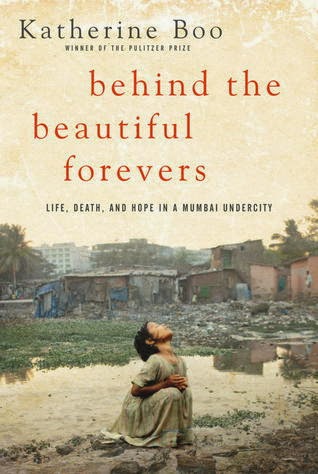Author: Katherine Boo
Genre: Narrative Non-fiction
Length: 262 pages
Rating: 4.5 Stars
Synopsis:
Katherine Boo chronicles the lives of an undercity (or slum) in Mumbai, India and the complexities and effects of inequality in her first book, Behind the Beautiful Forevers: Life, Death, and Hope in a Mumbai Undercity.While the lives and dreams of many Annawadi residents weave in and out of Boo’s narrative, Behind the Beautiful Forevers focuses on three individuals who are all striving to make it New India: Manju, aiming to become the slum’s first female college graduate; her mother, Asha, with the less principled goal of becoming the slumlord; and Abdul, who through focus, hard work, and a keen business sense tries to generate enough money from his family’s garbage business to buy a plot of land.
Review:
Behind the Beautiful Forevers is both a very easy and a very challenging book to read. Everything in the book is real (Boo lived in this community for three years), but the book reads like fiction. You get pulled in and engaged in these individual's stories. This is why Behind the Beautiful Forevers is also hard to read. It hurts. It's distressing. It pushes you to face the consequences of global inequalities and poverty.Abdul’s story was the most challenging to read—when a family feud spins out of control, Abdul is (wrongly) accused of murder alongside his father and sister, and their journey through the legal system has serious ramifications for Abdul’s successful garbage business. Asha’s story is perhaps the least sympathetic, but Boo manages not to demonize this character. Asha’s hard work and scheming allow her daughter, Manju, to attend college, which Asha hopes will help raise the entire family out of poverty.
The stories Boo captures give us a humanizing portrait of life in an undercity. “Do you ever think when you look at someone, when you listen to someone, does that person really have a life?” Abdul asks at one point. Behind the Beautiful Forevers gives all the people depicted a life. They may not be glamorous or particularly good lives, but gives Abdul, Manju, Asha, and everyone else an identity separate from their poverty.
I appreciated that Behind the Beautiful Forevers doesn’t offer any easy solutions. If anything, it highlights the complexities of anti-poverty work. Charitable efforts to promote education, microfinance, and health conditions are almost completed stymied by corruption. Government officials, elections, police, and local slumlord all support themselves through bribery.
In short, Behind the Beautiful Forevers is an excellent, engaging piece of narrative non-fiction that thoroughly deserves the National Book Award it earned. 4.5 Stars.
Editorial note: This review was drafted as a sample post in January 2013 when this blog was still an idea. I recently found the review and decided to edit, reformat, and publish it.


It's crazy that you just decided to post this, since I started it last night. Weird. :)
ReplyDeleteHas it been in the press recently for something? I've had several people start reading it or mark it as to-read recently, which is why I remembered this old review.
ReplyDeleteI'm interested to hear what you think. It's probably better than 'The Story of Mankind," at least.